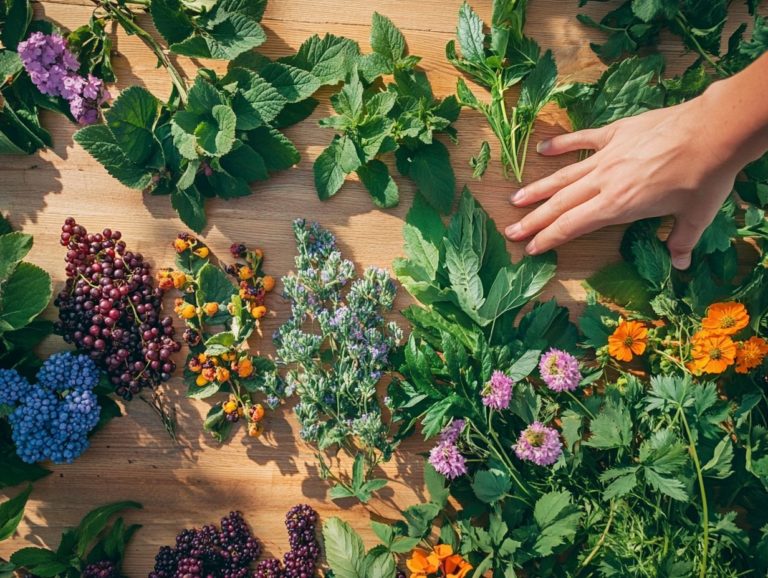Seasonal Edibles: What to Forage in Winter
Embracing seasonal eating can infuse your winter meals with a vibrant twist. Foraging presents a unique opportunity to connect with nature while unearthing delicious, nutrient-rich foods.
This article delves into common plants you can forage during the colder months. It showcases their edible parts and the best preparation methods. With essential safety tips to navigate potential risks, sustainable foraging practices, and inventive recipes to incorporate these winter treasures into your diet, you’ll be fully equipped to savor a season filled with flavorful foraging.
Contents
- Key Takeaways:
- Edibles to Forage in Winter
- Safety Tips for Winter Foraging
- Sustainable Foraging Practices
- Incorporating Winter Foraged Foods into Your Diet
- Frequently Asked Questions
- What are seasonal edibles?
- What can I forage for in winter?
- Are there any dangers associated with foraging for seasonal edibles in winter?
- Can I forage for mushrooms in winter?
- What are the benefits of foraging for seasonal edibles in winter?
- Where can I learn more about foraging for edible plants in winter?
Key Takeaways:
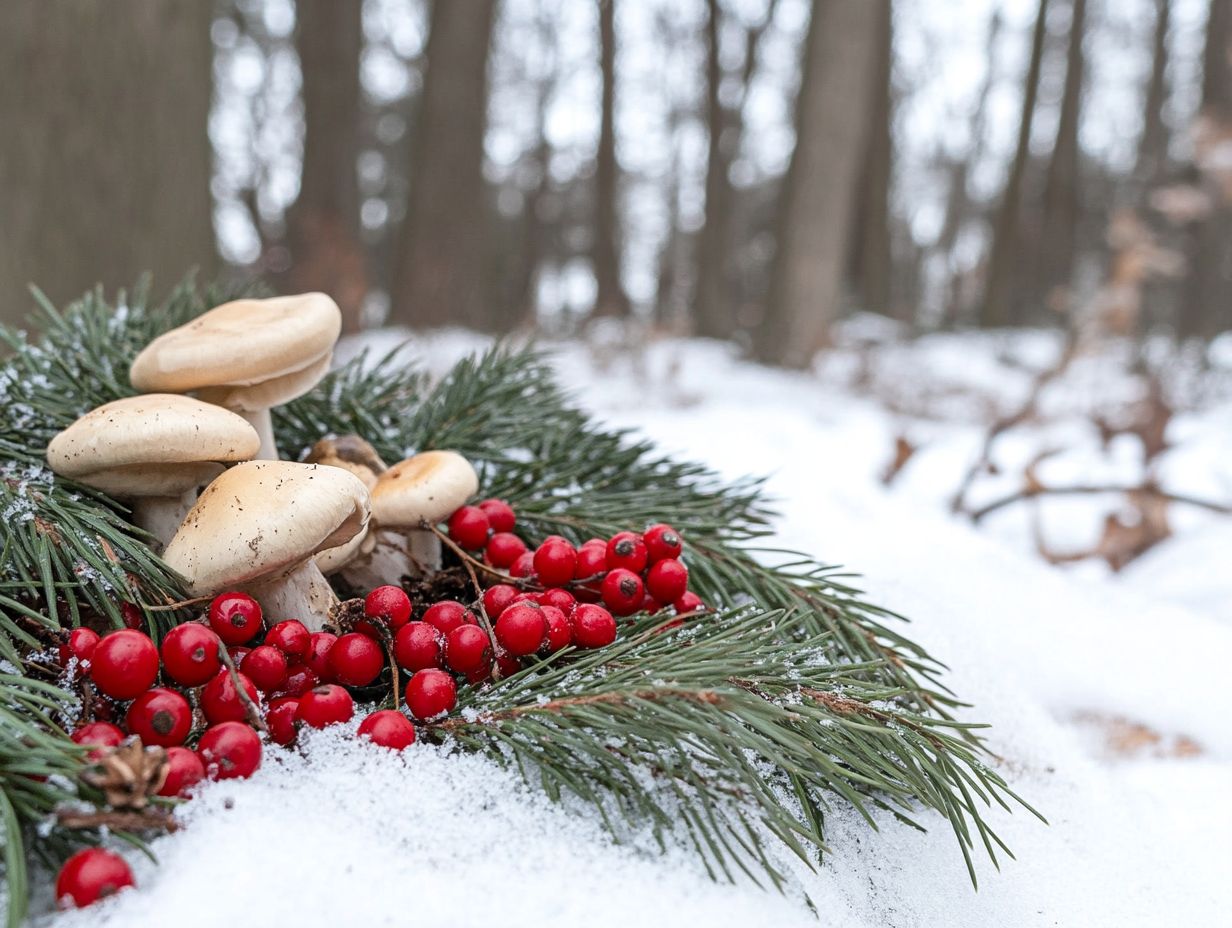
- Incorporating seasonal edibles into your diet can provide numerous health benefits, such as increased nutrient intake and reduced environmental impact.
- Discover winter plants like rose hips, pine needles, and wintergreen that you can use in teas, syrups, and soups.
- When foraging in winter, it’s important to be aware of potential risks, such as exposure to toxic plants and harsh weather conditions. Take precautions and educate yourself on safe and sustainable foraging practices.
Benefits of Seasonal Eating
Seasonal eating deepens your connection to nature and elevates your overall health by providing you with nutrient-rich foods at their peak freshness.
In winter, foraging opens up a treasure trove of edible and medicinal plants. These include juniper berries and conifer needles, which deliver vital vitamins and minerals during the colder months. For a comprehensive approach, check out the seasonal guide foraging through the year, as it can significantly support your immune system and boost your energy levels.
By embracing these natural offerings, you can cultivate a sustainable lifestyle that honors local ecosystems and fosters biodiversity. This practice cuts down on the carbon footprint associated with transporting food over long distances and enriches your understanding of the local environment.
You ll become more attuned to the seasonal changes and the unique flavors they bring. Enjoy the refreshing zing of wild garlic or the delightful tartness of winter cress. Engaging with local flora enhances your cooking skills and plays a vital role in preserving traditional foraging knowledge and practices that have nurtured communities for generations.
Edibles to Forage in Winter
Winter is the perfect time to discover a hidden treasure of edible plants waiting to be foraged!
From the tangy hawthorn berries to the refreshing hints of wintergreen, mastering the art of identifying these wild edibles can elevate your diet. This introduces unique flavors and health benefits that many tend to overlook.
Common Winter Foraging Plants
Several common plants can be foraged during winter that provide essential nutrients and flavors. These include dandelion root and chickweed, making them ideal additions to your foraging list. Learning to recognize these wild edible plants enriches your cooking skills and strengthens your connection to the environment through the practice of wildcrafting, which is the collection of plants from the wild for food and medicine. For more details, check out the seasonal foraging guide to discover the best times to gather wild edibles.
Among these, sprouting brassicas like kale and coltsfoot are standout finds. They re celebrated for their robust flavors and impressive nutritional profiles, packed with vitamins A and C. You might also stumble upon watercress thriving near streams, its peppery taste perfectly suited for enhancing salads and soups.
Keep your senses alert for wild garlic, identifiable by its distinct aroma, which can elevate a variety of dishes with its savory twist. Each of these plants offers unique health benefits, ranging from antioxidants to essential minerals. Winter foraging isn t merely about survival it s a delightful journey that enriches your diet with nutritious, wild foods.
Edible Parts and Preparation Methods
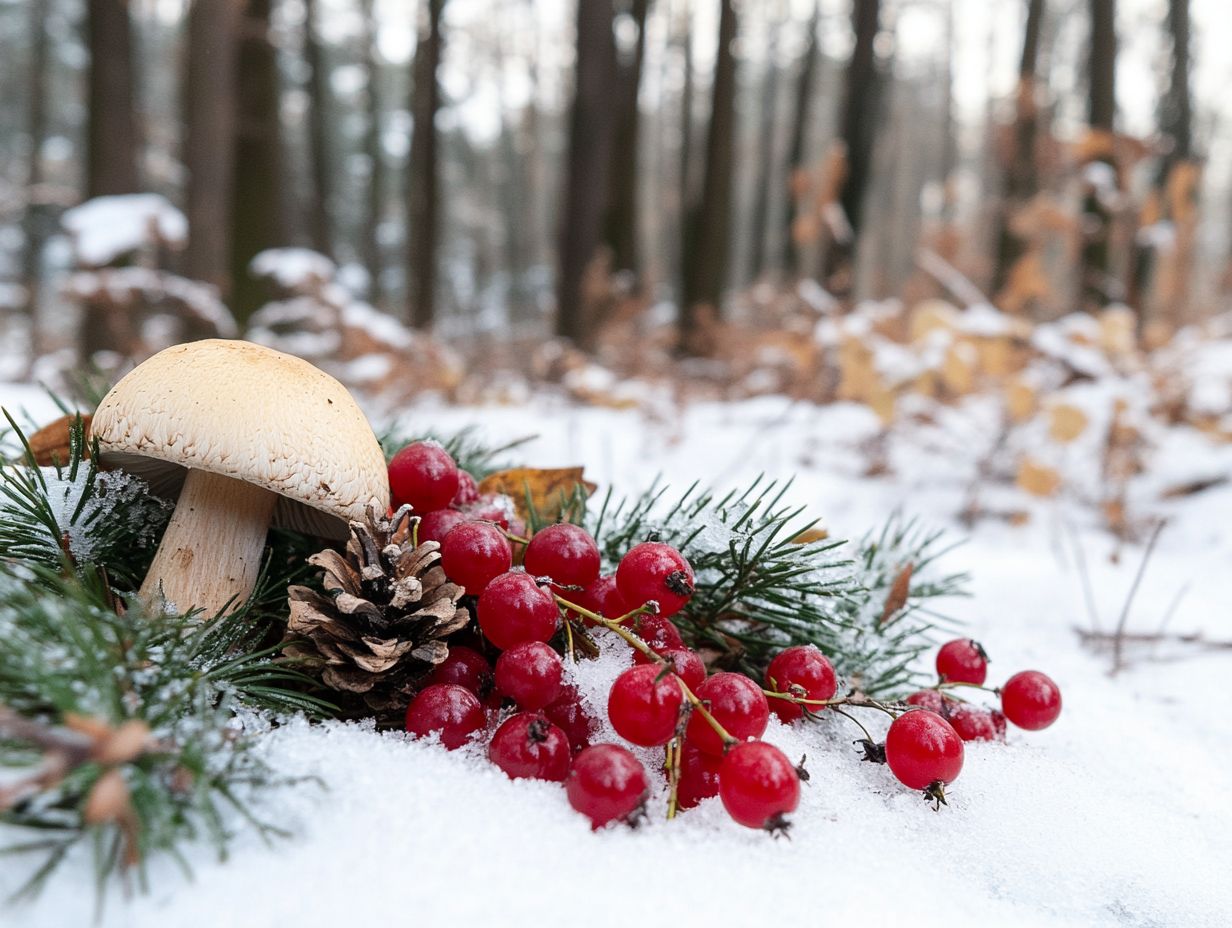
Know the edible parts of plants, like birch bark and hickory nuts. Each part adds unique flavors and nutrients.
Make drinks from conifers and use chaga fungus in your meals. These techniques will enhance your experience with wild edibles.
Delve into the diverse culinary uses of wild greens such as dandelion leaves and nettles. These can be saut ed to perfection or blended into hearty soups. Preparing these plants is often a straightforward affair. Methods like drying or boiling unlock their flavors and provide necessary nourishment during the colder months.
Take dandelion root, for instance. It can be roasted to create a delightful caffeine-free coffee substitute, infusing your winter beverage routine with a rich, earthy flavor. Experimenting with these recipes adds variety to your meals and deepens your connection to nature.
Safety Tips for Winter Foraging
When you embark on winter foraging, prioritizing safety is vital. To enhance your experience, consider using a seasonal foraging checklist to be mindful of potential risks in colder conditions.
It s essential to know the significance of accurate plant identification and to avoid toxic look-alikes, such as specific lichen species. This knowledge helps you enjoy wild edible plants while protecting your health.
Potential Risks and Precautions
Engaging in winter foraging has its risks, particularly the chance of misidentifying toxic plants or consuming contaminated wild edibles. You must act now to avoid these risks. Arm yourself with knowledge and the right tools, like enrolling in foraging courses.
As a novice forager, you will grapple with distinguishing between safe and hazardous species. Be mindful of environmental factors affecting plant quality. During colder months, contamination from pollutants or pests may become more pronounced.
To enhance your safety and success, consider using trusted field guides and attending local foraging workshops. These resources offer invaluable hands-on experience, teaching essential identification skills and the importance of sustainable foraging practices. This way, you can ensure both the ecosystem and you, as a forager, remain protected.
Sustainable Foraging Practices
Sustainable foraging practices are crucial for maintaining ecosystem health, allowing you to enjoy wild edible plants like cranberries and Oregon grape.
By following responsible wildcrafting guidelines, you actively contribute to the preservation of natural habitats. Your choices in foraging can make a significant difference in the environment around you.
How to Forage Responsibly
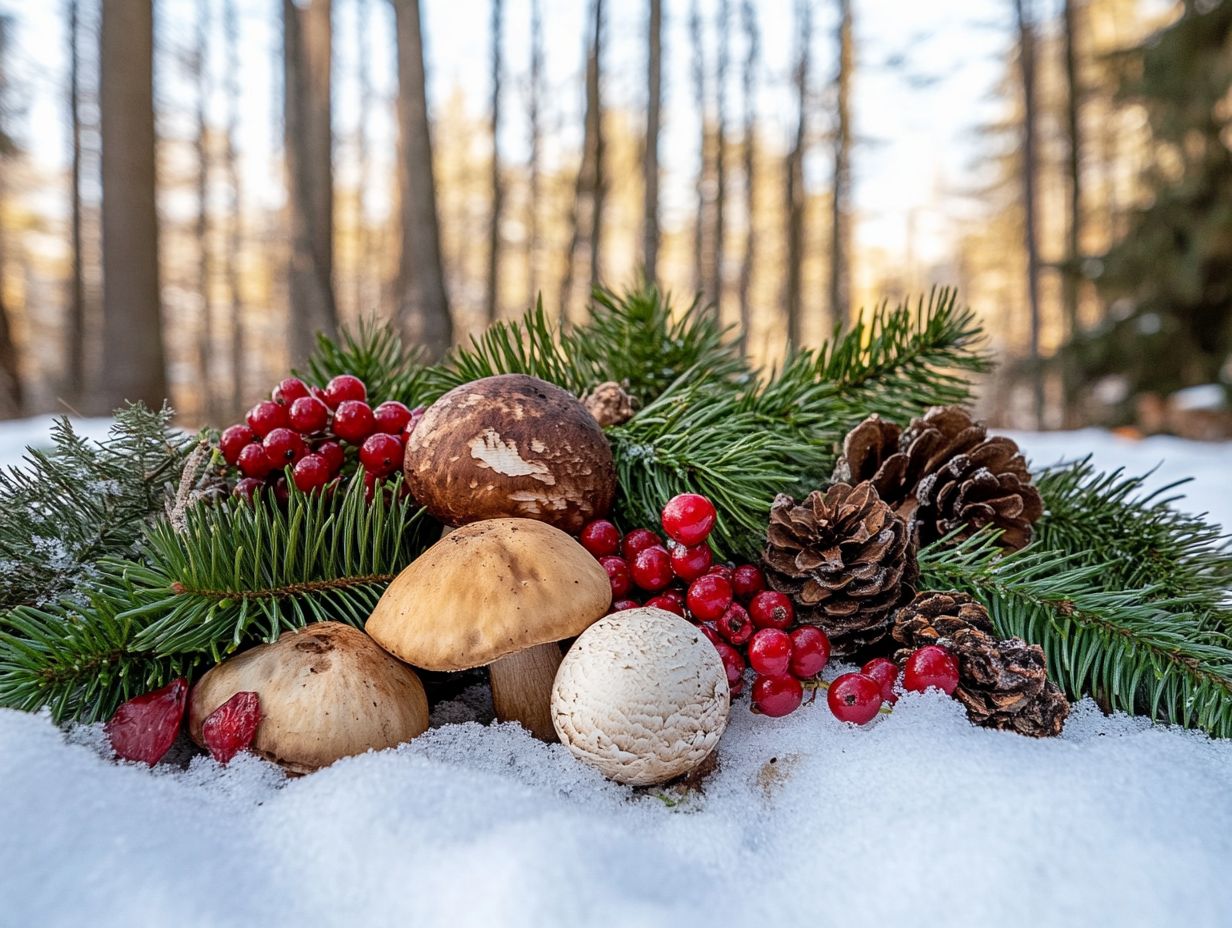
Foraging responsibly means understanding local regulations and ethical practices when gathering wild edible plants. This approach supports environmental sustainability.
By focusing on sustainable practices like harvesting only what you need and avoiding over-collection you can relish nature’s bounty while safeguarding it for future generations.
Awareness of local laws is crucial; certain areas may impose restrictions to protect native species. Adopting ethical harvesting methods, such as using clean tools and minimizing damage to plant habitats, helps preserve our precious ecosystems.
You can enhance your knowledge about identifying edible plants and their seasons by tapping into educational resources, including workshops and community foraging groups. When foraging for mushrooms, it s essential to recognize which varieties are safe to eat and to adhere to local guidelines regarding collection limits.
Engaging in these responsible practices elevates your foraging experience while making a meaningful contribution to protecting different kinds of plants and animals.
Incorporating Winter Foraged Foods into Your Diet
Incorporating winter foraged foods like dulse and kelp into your meals can truly elevate your culinary experience. These ingredients offer unique flavors and nutritional benefits that store-bought alternatives often lack.
Embracing these wild edibles enhances your culinary experience while cultivating a sustainable lifestyle that honors nature s bounty.
Recipes and Meal Ideas
Dive into exciting recipes that will transform your meals! Exploring creative dishes with winter foraged ingredients like turkey tail mushrooms and watercress invites you to embrace a more adventurous approach to cooking. For more tips, check out our seasonal guide on foraging techniques.
These meal ideas showcase the unique flavors of wild edibles and champion the sustainable practice of using locally sourced ingredients.
By incorporating these seasonal treasures, you celebrate nature s bounty while enhancing the nutritional value of your dishes. Imagine crafting a sumptuous turkey tail mushroom risotto, brimming with antioxidants and prebiotics that help good bacteria in your gut, or preparing a vibrant salad with peppery watercress loaded with vitamins A, C, and K.
Foraged foods carry a rich tapestry of traditional uses, adding depth and storytelling to your dining experience. Engaging with these ingredients nourishes not just the body but also rekindles your connection with the environment, deepening your appreciation for local ecosystems.
Frequently Asked Questions
Curious about foraging? Here are some top questions answered!
What are seasonal edibles?
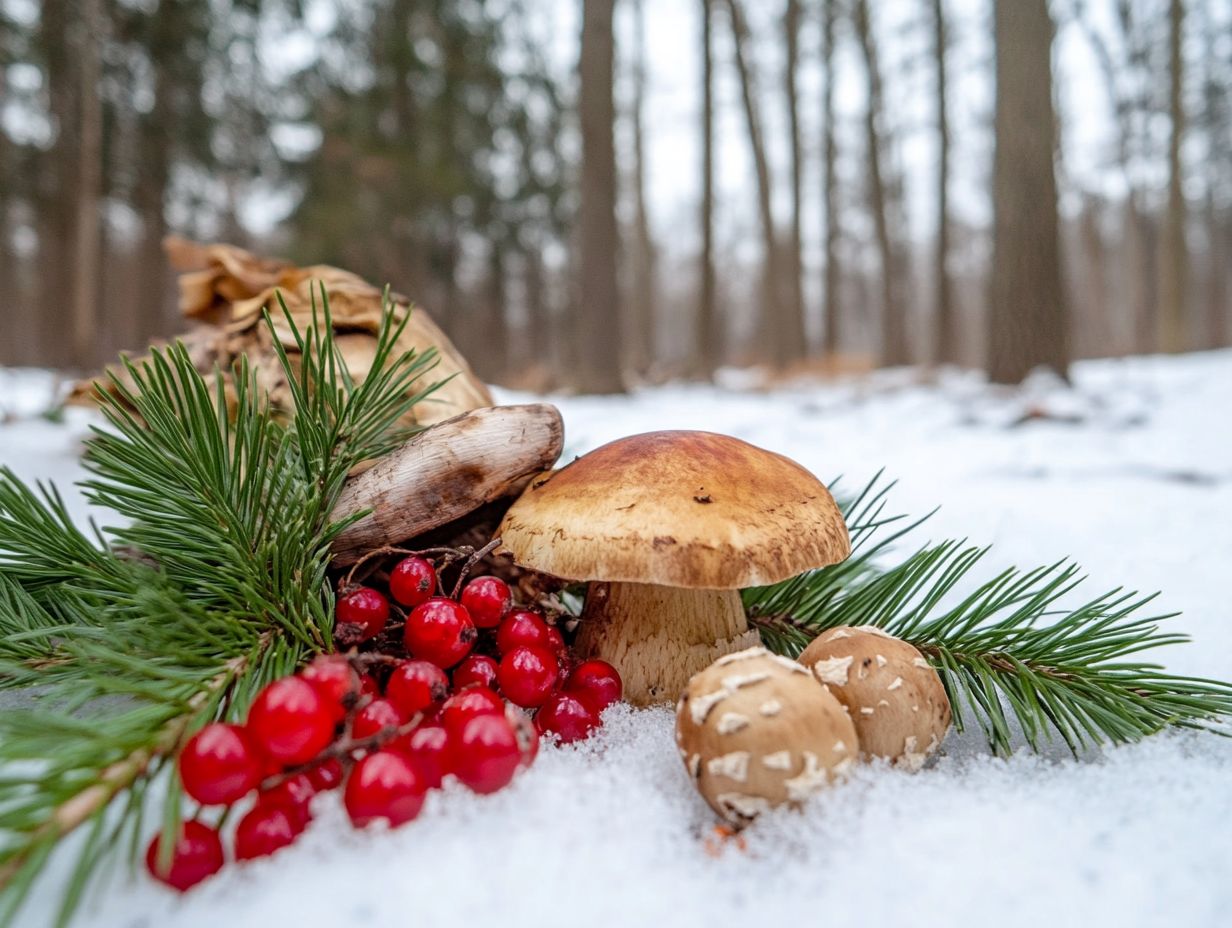
Seasonal edibles are foods available only during certain times of the year. These foods are often found in nature, and knowing the best locations for winter foraging in your area can help you forage for them effectively.
What can I forage for in winter?
In winter, common seasonal edibles that can be foraged include root vegetables like carrots and parsnips, as well as leafy greens like kale and spinach, as detailed in winter foraging.
Are there any dangers associated with foraging for seasonal edibles in winter?
While foraging can be fun and rewarding, it’s essential to be cautious. Make sure you can properly identify the plants you’re foraging for and avoid areas that may have been treated with pesticides or other chemicals.
Can I forage for mushrooms in winter?
While some mushrooms can be found in winter, it is generally not recommended to forage for them during this season. Many mushrooms are dormant in winter and can be challenging to identify. Instead, refer to seasonal foraging tips for gathering other types of seasonal edibles.
What are the benefits of foraging for seasonal edibles in winter?
Foraging for seasonal edibles in winter provides a great opportunity to connect with nature and learn about native plants in your area. If you’re curious about what to look for, you can explore what edible plants you can forage in winter. It can also be a cost-effective way to add fresh and nutritious foods to your diet during the colder months.
If you have more questions or want to share your foraging experiences, feel free to reach out!
Where can I learn more about foraging for edible plants in winter?
Many resources can help you learn about foraging for edible plants in winter.
Check out online articles, join a local foraging group, or attend a workshop to dive into this exciting skill!






